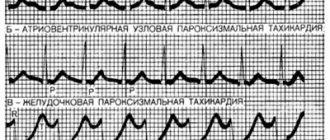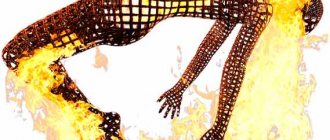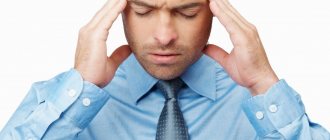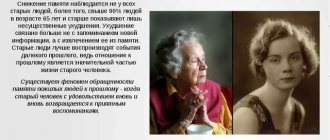Many patients suffering from panic attacks noted that the onset of a neurotic disorder was accompanied by fear for their life. The patients suspected the onset of a hypertensive crisis and sought medical help. However, their blood pressure turned out to be normal, and against the backdrop of absolute physical health, they often had to listen to almost accusations of simulation in order to obtain sick leave.
The problem is that panic is always accompanied by symptoms similar in manifestations to the symptoms of hypertension.
Why do pressure surges occur during panic attacks?
Every person suffering from VSD syndrome needs to remember the main thing: the pathology does not have an organic origin, that is, it is not associated with disturbances in the functioning of any organ.
All symptoms that arise relate to neurotic manifestations, which means they are amenable to psychotherapeutic intervention.
The diagnosis of VSD does not indicate the presence of a disease, it implies a neurosis that is quite amenable to correction.
Therefore, all the symptoms that appear during a panic attack come from the head rather than being a consequence of a serious illness.
You can often hear patients complain that during panic attacks, blood pressure rises, and weakness and dizziness may occur.
A person feels an increased heartbeat, feels hot or cold, and thinks about possible death.
Any specialist will reassure and explain to the patient that pressure during panic attacks often has nothing to do with heart disease; this symptom does not threaten health if you respond to it correctly and understand the cause of its occurrence.
It is worth paying attention to what contributes to panic?
Statistics show that the main reason is thoughts about death, the unknown, and the development of serious illnesses.
A person begins to stress himself out and imagine scary pictures of the future.
How should an organism behave in this case, which quickly reacts to our slightest manifestations, even if they come from the head and hidden thoughts?
Naturally, sensing danger, which in fact does not pose any threat (these are just thoughts, imagination), he begins to trigger the work of all organs and hormones responsible for the feeling of fear.
The patient begins to feel:
- increased heart rate;
- rapid pulse;
- dizziness;
- nausea;
- unreasonable fear from not understanding what is happening.
The above symptoms are the body’s response to the release of adrenaline into the blood, which leads to the activation of the cardiovascular system and, as a result, an increase in blood pressure.
Thus, a person independently provokes pressure surges through his thoughts.
Therefore, it is extremely important to learn to understand what happens in the body when fear appears, cope with panic and respond correctly to the manifestations of a panic attack.
Worth seeing: Panic attacks with cervical osteochondrosis
Only a qualified specialist can help cope with attacks and independently cope with pressure surges.
VSD or hypertensive crisis?
Often people diagnosed with VSD “look for” diseases in themselves; this is one of the manifestations of a neurotic state.
Jumps in blood pressure lead many to think of a hypertensive crisis.
In fact, any person can independently check assumptions regarding pathology at home.
To know how much pressure increases, you need to know your standard indicators
To do this, you need to conduct an experiment with holding your breath:
- when a person arrives calm, it is necessary to measure blood pressure;
- then hold your breath and carry out the measurement manipulation again.
If at the same time the pressure changes by at least 25-30 mmHg. in an increasing direction, then we can talk about VSD syndrome.
However, only specialists after examination can make a final diagnosis.
The experiment is recommended for people who have not consulted a doctor about high blood pressure. This may be a reason to visit a neurologist or therapist.
First aid to the patient
People who have panic attacks regularly know what to do at this time in order to experience the inconvenience as comfortably as possible. When feelings appear, the attack begins, there is no need to panic, fuss, or complain to others about your fears. You need to try to relax, take a comfortable position, protect yourself from all irritants, and make sure that fresh air flows into the room.
Self-massage increases the chances of faster removal of a seizure. Exercises are performed alternately until the condition improves:
- The middle finger slowly presses the temples and massages for 30 seconds.
- Go to the eyeball and do the same work for 30 seconds.
Those around you need to calm down and try to help the person who is having a panic attack. First you need to talk to the victim, convince him that nothing bad will happen. If you manage to distract a person having an attack, the panic will stop without the use of medications.
If a person often suffers from panic attacks, it is worth knowing what to do during this period in order to survive it as comfortably as possible. First of all, if you have a feeling that an attack is beginning, you should not panic, fuss and bother others with far-fetched fear. You need to relax as much as possible, take a comfortable position, remove all irritants (bright light, loud sound), and provide a flow of fresh air into the room.
Algorithm of actions
- If your blood pressure has already increased, try to calm down by adjusting your breathing. To do this, you should slowly inhale air, hold your lungs full for 1-2 seconds, and exhale slowly, trying to concentrate on the process.
- Increases the chances of quickly eliminating an attack and self-massage of the temples and eyeballs. Perform the exercises alternately until the condition improves and the tension can be reduced:
- With the middle finger of your hand, first press a little on your temples and massage them for 30 seconds;
- go to the eyeballs and do the same action for 30 seconds.
If a person witnesses another person developing a panic attack and increased heart rate, you should calm down yourself and help the patient cope with the problem. First of all, the victim needs to be reassured, explained that nothing terrible happened and that he will not die. If the patient can be relaxed and distracted, the attack will subside on its own, without the help of medications.
If you or your loved ones are having a panic attack and there is a possibility of increased blood pressure, you need to take immediate action. Speed and correctness of actions can save lives and reduce negative consequences for the patient’s health:
- Provide free access to fresh air to the patient. Open windows, unfasten buttons, loosen collars and cuffs. Make sure that the person is not in a draft.
- It is necessary to lay or sit the person down to avoid loss of consciousness and minimize dizziness.
Blood pressure needs to be measured
- Measure the victim's blood pressure.
- Give the patient cool water with mint drops, Corvalol, Valocordin. You can put a Validol tablet under the patient's tongue.
These measures will help reduce blood pressure and calm your nerves. The victim needs to be calmed down and distracted from the situation that led to the panic attack. If panic attacks appear regularly, you need to take your health seriously and get treatment.
To cure pressure surges during panic attacks, it is necessary, first of all, to normalize the patient’s emotional state and teach him to cope with stress and difficulties. Doctors prescribe:
- Herbal and chemical based sedatives. They help stabilize your mental state. Can be taken during the day or during periods of stress.
- Antipsychotics and tranquilizers help fight attacks of hysteria.
- Drugs that support the heart muscle. These are mainly products based on B vitamins, hawthorn fruits, amino acids, and meldonium.
B vitamins
- Vitamins to support the nervous system and heart. B vitamins and microelements (potassium, magnesium) are used.
- Antihypertensive drugs, if the patient has hypertension or is prone to it.
In addition to medications, psychotherapy, folk techniques, massage, and aromatherapy are widely used.
A psychotherapist will teach you to cope with life's difficulties and perceive stressful situations differently.
Low pressure
When diagnosing VSD, you should pay attention to the type of disease.
In other words, neurologists talk about “VSD syndrome of the hypertensive type” or “VSD syndrome of the hypotonic type,” which has a significant difference .
Patients with the first diagnosis may have optimal blood pressure in a calm state; it increases only with the onset of panic attacks.
The second implies the constancy of low blood pressure.
A person with this syndrome experiences many symptoms, which include:
- general weakness;
- dizziness;
- decreased performance;
- fatigue;
- headache;
- nausea;
- bowel dysfunction, leading to constipation or diarrhea.
Unlike hypertensive patients, hypotensive patients experience instability in blood pressure almost constantly.
They get used to living with ailments associated with low blood pressure.
If we consider the pressure during panic attacks in numbers, then hypertensive patients with good health have readings of 120/100, 130/100; when panic occurs, it can increase to 150-160/100 mmHg.
Hypotonics are within the following indicators: 90-100/50-60.
With these numbers, they feel overwhelmed, concentration falls and the pulse is minimally palpable. Cardiac activity can cause discomfort.
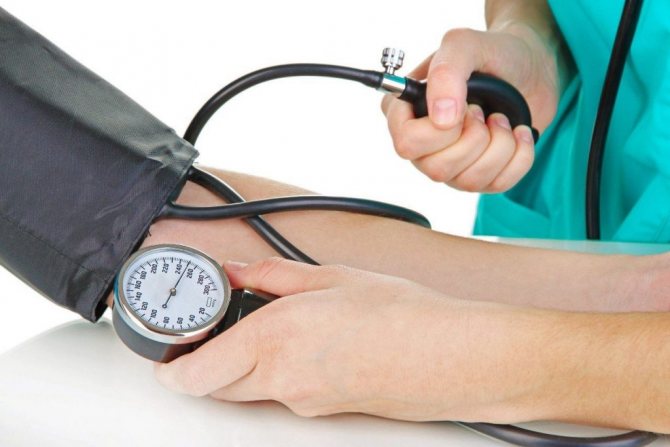
Sometimes the pressure, on the contrary, decreases
If hypertensive patients are worried about a rapid heartbeat and all the accompanying symptoms, then hypotensive patients are worried about its rhythm, which sometimes feels like it disappears, which causes panic and, as a result, an increase in blood pressure.
They often feel weak after a panic attack; fear increases anxiety, which can lead to fainting.
It is worth noting that a decrease and increase in blood pressure (blood pressure) are manifestations of neurosis .
Therefore, the main task is not to search for pathologies that may well not exist, but to consult a good psychotherapist or psychiatrist.
You need to learn to control your emotions and body, then any attack will be easy to overcome.
Worth seeing: Signs of a panic attack
What to do?
When a patient has a panic attack more than once, the pressure rises sharply and the condition worsens, you need to contact a specialist for advice. Such disorders are common among psychotherapists and psychiatrists. They refer their patients for diagnostic procedures.
In addition to psychotherapy sessions, psychotropic drugs, antidepressants, and pills to strengthen the heart muscle and blood vessels are used. During treatment, patients are regularly monitored by specialists who can adjust therapy if necessary. Thanks to such approaches, it is possible to quickly relieve symptoms and stabilize the condition.
Physiological connection
At the root of any psychosomatics is a ban on the expression of one or more emotions. These are usually socially condemned emotions like fear and anger. Fear and anger are normal states that once helped humanity survive and develop.
Unfortunately, sometimes even the most harmless expressions of fear and anger are frowned upon. Then a person develops an internal ban on the manifestation of these emotions, and he suppresses them. First consciously, and then as an automatic reaction.
However, the emotion itself is preserved and all changes at the level of the organism, thanks to which it arises, are preserved. When the body is faced with a situation that is unsafe, the normal reaction is either to activate an internal resource to fight or to avoid the stressful situation. Of course, this increases blood pressure during panic attacks.
To do this, the adrenal glands secrete a number of hormones (steroid hormones), which cause a number of psychophysiological reactions:
- contraction of the walls of blood vessels;
- heartbeat and pulse increase;
- rise in blood pressure;
- increased breathing;
- blood flow to all muscles;
- decrease in blood supply to the brain (animal reaction in order to redirect force to physical actions).
The same thing happens during a panic attack, but with higher intensity. What is this connected with? First of all, the higher the level of hormones, the less ability to respond to a stressful situation on the physical level. In other words, if there is a situation in which it is normal to be afraid, and there is an internal inhibition against fear, it remains encapsulated in the body in the only form available in this case. In the form of a bodily reaction. Since you cannot show your fear and interact with your body with the world around you, you can only experience it inside.
This may feel like extremely intense fear, a feeling of being unable to control your emotions and body, but this is just a consequence of the fact that the concentration of hormones increases due to the inability to transmit anger or fear to the outside world.
Diagnostics
In order to find out your blood pressure level, you simply need to measure it with a tonometer. Disorders of the cardiovascular system, such as tachycardia, bradycardia, hypertension or hypotension, are consequences of a panic attack.

You definitely need to see a therapist
To identify it and correctly prescribe treatment, you should visit specialists such as:
For differential diagnosis, you may be prescribed various examinations (general blood count, ultrasound with Doppler ultrasound of the heart, blood vessels of the neck, head).
Prevention
Prevention, which is aimed at preventing the development of a panic state and control over one’s well-being, can increase the chances of successfully overcoming panic. Relaxing breathing exercises from yoga, which should initially be done in the presence of a master, have a good effect. During PA, it is worth applying the exercises in practice, then you will be able to concentrate in time and prevent further development of the attack.
Do not forget about generally accepted preventive measures - healthy sleep, active recreation, walks in the fresh air, proper nutrition. People who suffer from VSD and panic attacks should completely eliminate bad habits from their lives, quit smoking, monitor their health, and take vitamins as recommended by their doctor. Then the frequency of PA will decrease, and the person will be able to live a full, happy life.
In any case, panic attacks must be treated, as they are fraught with increased blood pressure and a deterioration in the patient’s health. Preventive measures include healthy, full sleep, adherence to work and rest schedules, and proper nutrition.
Every day you should be in the fresh air. Of course, in a metropolis and constant rush, this is difficult to achieve. Make it a rule: on your way to or from work, walk. During your lunch break, go outside the office building. Learn to appreciate beauty - the first flowers, the yellowness of autumn leaves, bright umbrellas on a rainy day.
Only by eliminating bad habits and normalizing your mental state can you forget about panic attacks and increased blood pressure.
Prevention aimed at preventing the onset of a panic state and controlling well-being allows you to increase the chances of successfully overcoming panic. A positive effect can be achieved from relaxing breathing exercises; several yoga exercises should be performed for the first time under the guidance of a specialist. During PA, it is necessary to use exercises, as a result, you will be able to concentrate in a timely manner and prevent the subsequent development of seizures.
Medicines
For autonomic dysfunction, such medications are used. Benzodiazepine tranquilizers, which allow you to quickly eliminate a seizure, are used once because they are addictive. Antidepressants that do not impair the functioning of the nervous system. The result can be obtained after 2 weeks.
The duration of the course of therapy is six months. The drugs require regular use, regardless of when the seizure begins. Vitamin B supplements help strengthen the nervous system.
Some are mistaken in believing that traditional medicine can treat neurosis. These drugs have too little sedative effect; their use is advisable only when used in combination with psychotropic drugs.
Patients often prescribe PA therapy by visiting a psychologist. This is not a medical specialist, he lacks competence in determining the causes of the crisis, and has no authority to prescribe medications. Neurosis can only be overcome by the joint work of neurologists and a psychiatrist.
To completely eliminate PA, the following conditions must be met:
- Identify reasonable specialists and personally contact them for support.
- It is necessary to follow all doctor's recommendations regarding the approved course of therapy. The established time limits must not be violated.
- A positive result from therapy can be obtained if you treat the treatment with patience and responsibility.
Cognitive-behavioral treatment method
Melissa medicinal herb for blood pressure
We invite you to familiarize yourself with Drugs for varicose veins: a review of drugs for varicose veins
You can prepare decoctions and make tinctures from medicinal raw materials.
The essence of the technique is to provide a therapeutic effect on the functioning of the psyche of a person who is in the stage of hypnonic sleep. The specialist forms in the patient a different attitude towards the crisis. If a person is in a hypnotic state and cannot reasonably build a defense through speech and neuralgic influence, it is possible to obtain the necessary information.
Cognitive behavioral therapy addresses the goal of consciously eliminating habitual behavior patterns that cause a seizure. During such treatment, a new psychological attitude is created in a person. A person convinces himself that a state of anxiety will not harm him. As a result, PA is no longer a disaster, the fear of death is eliminated.
